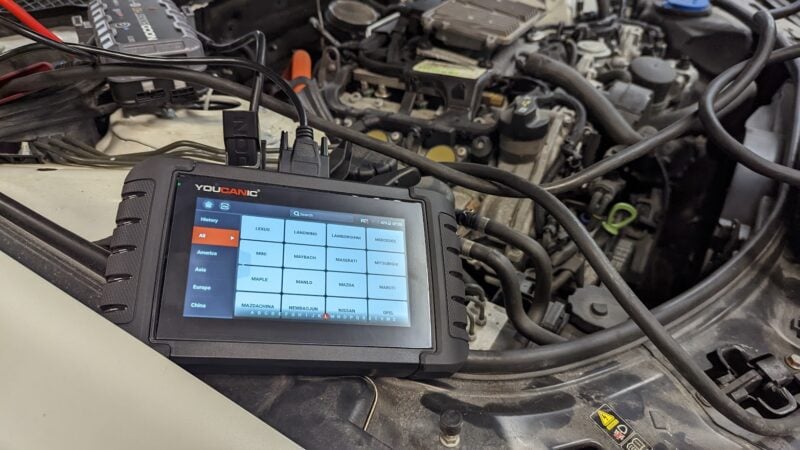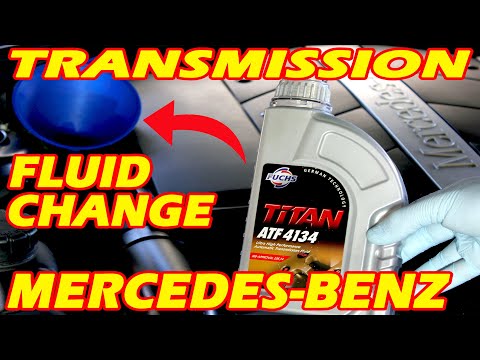You should consider changing the automatic transmission fluid and filter on your Mercedes-Benz every 60,000 to 80,000 miles. Years ago, Mercedes-Benz claimed these transmissions were sealed for life and didn’t require an oil change. But their recommendation on transmission fluid has changed, and now they recommend changing it.
Many owners and mechanics believe that if you change the transmission fluid, you may experience transmission problems. The argument used to support that claim is that the transmission will act up because the viscosity of the old oil has changed compared to the new. Or that particles may be dislodged inside the transmission, which can clog the new filter.
Our recommendation is to change the transmission fluid to extend the life of the transmission.
Required Transmission Oil
You will need 10 quarts of transmission fluid. Mercedes-Benz recommends that you use the MBZ ATF 236.14 transmission fluid. The only problem is that oil sells for around $20 per liter.
Transmission Fluid Alternative
 If you are looking for an alternative to Mercedes-Benz oil, we would recommend the Valvoline MaxLife or the Shell 134 transmission fluid. It is essential to understand that Mercedes-Benz doesn’t have these two fluids on its approved list. That doesn’t mean that these fluids don’t meet the required specification. The same 722.6 transmissions are used in many Dodge cars, and Dodge does use the Valvoline MaxLife in the same transmission. We have also used the Valvoline MaxLife in multiple Mercedes-Benz cars and have not experienced any problems. Valvoline Maxlife says their oil suits Mercedes-Benz, and Shell states it meets the MB specs.
If you are looking for an alternative to Mercedes-Benz oil, we would recommend the Valvoline MaxLife or the Shell 134 transmission fluid. It is essential to understand that Mercedes-Benz doesn’t have these two fluids on its approved list. That doesn’t mean that these fluids don’t meet the required specification. The same 722.6 transmissions are used in many Dodge cars, and Dodge does use the Valvoline MaxLife in the same transmission. We have also used the Valvoline MaxLife in multiple Mercedes-Benz cars and have not experienced any problems. Valvoline Maxlife says their oil suits Mercedes-Benz, and Shell states it meets the MB specs.
Tools & Parts Needed
To change the transmission fluid oil, you will need the following:
- 5 mm Allen wrench
- Mercedes-Benz 722.6 Transmission Fluid Dipstick Tool
- Transmission Filler Lock Pin
- Mercedes-Benz Transmission Filter & Gasket Kit 722.6xx 1400095
We recommend using a complete kit that includes the filter and gasket.
Instructions on how to change Mercedes-Benz automatic transmission fluid and filter.
-
- Set your emergency brakes. Jack up the car on the front if you do this job at home. Not necessary to jack up all four wheels.

- Remove the engine undercover. The panels under the engine are held in place with 8 mm bolts.


- Remove the 5 mm bolt under the transmission using an Allen wrench. Be careful, as the fluid may still be hot.

- Drain oil from the torque converter and the transmission oil pan. Not all models have a torque converter drain bolt. The access hole for the torque converter was removed from the transmission casing in the early 2000 models. Let the oil drain for at least five minutes or until no oil drips from the transmission pan.

- Remove all the oil pan bolts. Lower the oil pan but be careful because you may still have oil that is still in the pan.

- Pull down on the transmission oil filter.

- Install a new oil filter by pushing it up.

- Clean the pan and the magnet if your car has one.
- Install the new gasket and the oil pan.

- Install the drain plug.
- Fill the transmission with 4 quarts of oil. Drive the car for 5 min.
- Check the automatic transmission fluid using a special Mercedes-Benz transmission dipstick, which you could get on Amazon. Read this article to know How to Check the Automatic Transmission Fluid.

- Set your emergency brakes. Jack up the car on the front if you do this job at home. Not necessary to jack up all four wheels.
Torque specifications
- Transmission pan bolts: 8Nn.
- Drain bolt: 20Nm
Troubleshooting Mercedes-Benz Transmission Problems

Changing the transmission oil filter and fluid won’t fix your transmission problems, such as hard shifts or limp mode. Mercedes-Benz cars suffer from valve body issues and conductor plate issues. If that is what you are experiencing, you must diagnose the problem by reading the fault codes from the transmission control unit. You can take the car to the dealer or troubleshoot it using the YOUCANIC full system scanner, which shows you the codes like the Star Diagnostic Scanner.

If you’re experiencing problems with your Mercedes-Benz, the YOUCANIC full system diagnostic scanner can be an invaluable tool for troubleshooting and diagnosing the issue. This scanner is designed specifically for Mercedes-Benz vehicles, allowing you to access and analyze data from your car’s various systems and modules.
With the YOUCANIC scanner, you can perform various diagnostic functions, including reading and clearing fault codes, monitoring live data, performing component activation tests, and more. This allows you to identify the root cause of the problem and take appropriate action to fix it, whether it involves replacing a faulty component, adjusting to a system setting, or performing more extensive repairs.
By using the YOUCANIC full system diagnostic scanner, you can save time and money by avoiding unnecessary trips to the mechanic and performing repairs yourself. Plus, with the ability to access real-time data and diagnostics, you can stay on top of your vehicle’s maintenance and prevent potential problems before they occur.













